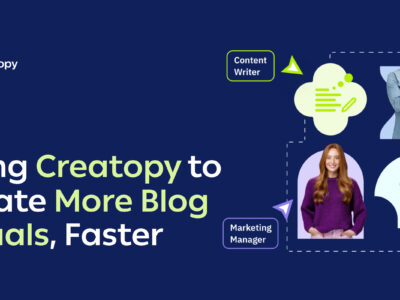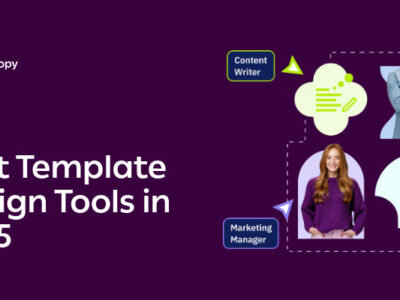Digital marketing automation is the process by which artificial intelligence (AI) and other tools are used alongside digital advertising tactics to enhance the overall digital marketing process. While some folks may be apprehensive of the digital world, automation is important to consider, for it can assist with several things.
One of the many benefits of implementing automation in your current digital marketing strategy is that it can help streamline content ideation and improve audience analysis techniques. Both of these are vital if you wish to run a successful digital marketing campaign. Additional benefits of automation in digital marketing include:
- Optimized lead generation. Lead generation is the process of accumulating sales inquiries from potential customers. You must cultivate messaging that attracts potential customers from all areas of advertising, like on LinkedIn, not just your website.
- More time for lead nurturing. Lead nurturing is the process of following up with a potential sale from a consumer who is on the fence about investing in your products/services. Implementing automation in your marketing department can free up the time you’d spend curating relevant messaging and allow you to spend more time with potential customers.
- Improved user experience (UX). Just as it sounds, user experience (UX) is how consumers feel when visiting your website and/or interacting with your advertisements. Automation can help improve the overall user experience by helping marketing professionals generate user-friendly content and media.
- Enhanced customer and business data retrieval tactics. Some professionals utilize manual data retrieval tactics to enhance current marketing tactics. Integrating automotive software into the equation can help reduce the amount of time these professionals are spending acquiring customer and business data by analyzing it with more accuracy and efficiency.
We can safely assume that automation in digital marketing isn’t going away any time soon. This is why you should consider embracing it sooner rather than later. Additionally, the sooner you decide to incorporate automation, the sooner you can get your staff up to par on current processes.
Throughout this guide, you’ll learn how to educate your marketing team on the value of automation in digital marketing and tips for embracing the ever-growing trend.
Embracing Automation’s Applications in Ad Campaigns
Automation plays many parts in digital marketing. For instance, those who apply AI or other automation software to their marketing strategy can expect faster production speeds, minimizing menial tasks, and enhanced data analytics.
Luckily, that’s not all it can do. Let’s take a closer look at how automation can enhance marketing and advertising campaigns.
Concept and topic ideation
As briefly mentioned above, automation software can be used to streamline the topic ideation and concept planning processes. This includes, but certainly isn’t limited to, ideating content for social media advertisements.
To automate topic ideation for things like blog and social media posts, you could choose from one of many AI tools — or try multiple solutions to see what sticks. These include:
- Narrato Workspace;
- Semrush Title Generator;
- Copy.ai Content Idea Generator;
- ChatGPT;
- Hubspot Blog Ideas Generator.
Enter a prompt based on what you need. Each tool has its own framework; for example, Hubspot simply requires you to enter a noun and you’ll get five ideas. However, ChatGPT will generate as many ideas as you ask it for, but there are diminishing returns, as many ideas can end up being redundant. Still, there’s likely to be a number of kernels worth grasping or something that inspires you further. You could populate a spreadsheet with the best ideas and use a calendar or project management software solution to line up the next steps in the creation process.
Work on refining your prompts to generate better ideas. For example, instead of saying, “Generate seven blog post topics about personalized marketing,” be more specific with a prompt such as, “Generate seven blog post topics about personalized marketing in social media.” Of course, you’ll want to base this type of specificity on the problems your audience is trying to solve. Consider using a tool like Semrush to automate keyword research and regularly plug your audience’s top queries into the topic generator.
Not only can automation speed up the topic ideation process, but it can analyze consumer patterns to help determine relevant content to publish to your website and social media platforms as well. Performing these tasks at enhanced speeds takes away the manpower typically needed to see them out, allowing them to be allocated elsewhere.
Digital analytics
TechTarget defines content analytics as “the act of applying business intelligence and business analytics practices to digital content.” Marketing professionals use this data to improve their marketing plans. Specifically, they use data gathered from audience analysis to determine their target audience, what content they desire, and whether or not this messaging exists on all company platforms.
Analytics tools allow you to analyze your website traffic (Google Analytics), discover the keywords your audience is using (Semrush and Ahrefs), and track clicks in your marketing campaigns (Bitly). These are just a few of the metrics you can analyze with software solutions that automate the analysis. Decide what you want to know for each campaign and search for a solution that will automatically track, analyze, and summarize findings. Then turn these insights into action, whether that means developing a content calendar or a set of banner ads based on clicks or engaging influencers with whom your audience resonates.
Implementing automation paired with other online marketing tools is a great way to collect infinite amounts of relevant data needed to improve marketing tactics. Additionally, investing in these digital tools can help create a safe and secure storage space for the found data.
Adaptation
Adaptation in marketing refers to adjusting your approach based on your audience’s reception of your messages. Take email marketing — where automation often comes into play — for example. Act-On makes a fine point when they note that consumers’ perception of what qualifies as spam is probably broader than what marketers think spam is.
The number one reason people mark something as spam is that a brand sent too many emails that the recipient deemed irrelevant. Whether it’s emails or ad placements, adaptive marketing accounts for consumers’ perception and adjust accordingly.
Continuing with the email example, you could either instruct your marketing team to go old school and spend time hand-crafting emails to qualified candidates. Or you could speed things up and deliver highly personalized messages to those candidates with automation software such as an AI mail writer.
Adaptive marketing relies on every piece of consumer data you have available to maximize relevance based on the audience’s reception of marketing messages. This can include names, geographic data, clicks, app usage habits, occupation, and each data point on their journey with your company. The reason you’re adapting in this way is that the wide-net approach isn’t working.
For example, the language-learning app Duolingo normally sends automated reminders to use the app daily. But when you ignore these messages, you don’t open them, and you don’t open the app, Duolingo sends an automated message to the effect that it’s noticing these reminders don’t work, so it’s going to stop sending them. In this case, the app lets you know it can adapt its automation — it’s aware that automation could be annoying you, and therefore, you could view it as spam. Likewise, you can tell automation programs to stop and try a new approach when something isn’t working.
Email campaigns
Just as it sounds, an email campaign is a digital marketing tactic that relies on email to send company updates to multiple consumers at once. Email campaigns are an easy, yet effective marketing tactic that everyone from beginners to experienced professionals rely on. An article on email campaign statistics reports 77% of marketing professionals seeing an increase in email engagement over the past year. With how beneficial email campaigns are to your marketing strategy, it only makes sense to consider how to implement automation in them as well.
Email automation can start with your company’s customer relationship management (CRM) software, where all customer information and data — including email addresses — are housed. Here are some steps to consider:
- Choose an automation solution that integrates with your CRM, such as Omnisend or Mailchimp.
- Decide what you want to automate, such as when a customer abandons a digital shopping cart, a special offer to customers who haven’t purchased anything for a while, or a message/offer on customers’ birthdays.
- Segment a list of customers who will receive emails and tell the automation software when to trigger the outreach.
- Design the email. Be sure to use appealing visual elements like graphics and banners to showcase your branding, and make the message easy to understand.
- Test the email in-house or with a select group of customers before going full-scale.
- Activate the automation and monitor results. If your success rate is low, modify the message or offer accordingly.
In this way, you can use automation to improve your email campaigns by honing in on a target audience, allowing you to create the ultimate email marketing list. Additionally, automation can improve your email campaign by creating personalized emails to send to each subscriber.
Lead nurturing
While we briefly mentioned lead nurturing above, its importance in marketing wasn’t discussed. According to Business News Daily, lead nurturing is an inbound marketing tactic that “use[s] content marketing, social media, and other online communication methods to attract customers’ attention.” Lead nurturing is important because it helps increase conversion rates.
One study reports that companies that implement lead nurturing generate 50% more leads than those that don’t. Automation will only continue to enhance the benefits of lead nurturing by identifying campaign topics and generating content to complement these interests.
Here’s a quick and easy rundown of how to automate lead nurturing with your marketing team:
- Determine triggers and actions. A trigger is something a lead does that activates the automation, which then takes action. For example, a website visitor who clicks a link to your target page and then navigates away could trigger automation software to show them banner ads on other websites via cookies.
- Segment your audience based on lead stage and preferences. A lead who downloads your whitepaper and subscribes to your newsletter could be a qualified lead who might further engage with an ebook, webinar, or product demo. You can automatically send them an email accordingly.
- Instruct the software to take specific action based on lead engagement. Sometimes known as a drip campaign, this is where you tailor automated messages to audience segments based on where they are in the funnel. Someone who has simply signed up for your blog newsletter would automatically get a welcome message. But as they move further down the funnel — they download an ebook, say — they automatically receive an offer for a free demo of your service.
- Monitor engagement rates and conversions. As always, choose an automation solution that will report back on success rates and alter your campaigns based on what is and isn’t working.
Automation tools can assist with lead nurturing by ensuring relevant content reaches its target audience. Lastly, implementing automation is a great way to alleviate repetitive tasks, freeing up time to be allocated elsewhere.
Mid-campaign refresh
Taking the time out of a campaign to determine what strategies are working well and which ones to alter is necessary for success. This process is known as a “mid-campaign refresh” and is especially useful for those implementing new tactics, such as automation, into their digital marketing strategy.
What type of campaign are you running and how can it benefit from an automated approach? Say, for example, you’ve been manually plugging competitor websites into a keyword analysis tool to find gaps and help come up with blog post topics. But a tool like Kompyte can automatically analyze competitors and generate the type of data you’re looking for.
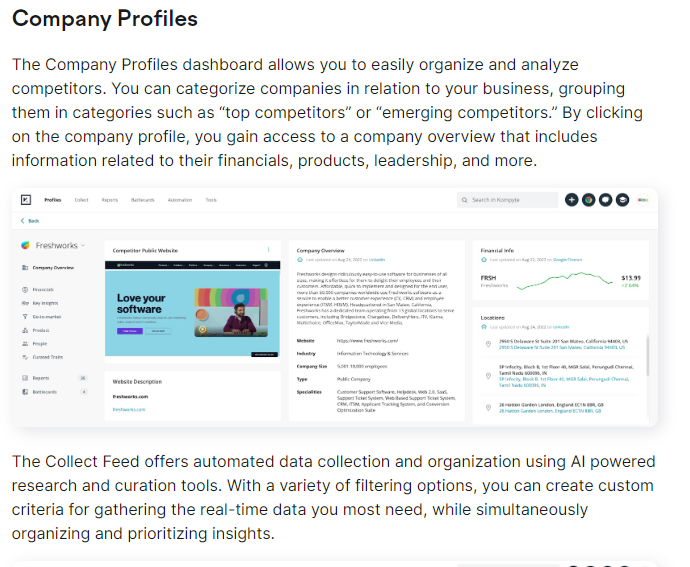
Image source: Semrush
To start automating mid-campaign, take a similar approach and ask questions about the steps in the ongoing process, whether you’re posting social media ads or creating blog posts. Search for tools that will complete repetitive steps for you.
The time you save by implementing automation can help you and your team look more critically at analytics and performance data, update marketing plans, implement more of what’s already working, and brainstorm new things to try. Analytics software can help content teams analyze data in real-time to gain better insight into which blog and social media posts are doing well, as well as which ones are lacking in views. Your team can then take this data and optimize the content that isn’t up to your new standards.
Provides a central hub for content
Another hidden gem of automation is how it provides marketing professionals with a central hub for all content. It’s common to use the same branding and contextual elements throughout all of your content, such as:
- Graphics/company logos;
- Digital banners;
- Images;
- Font style and size.
Brand consistency is vital to consumer awareness and trust. Instantly recognizable logos, font, colors, and tone lets customers know your brand, and they will grow to look for it if they trust it. Implementing creative software creates a single space where your marketing team can store these contextual elements across several digital marketing aspects without worrying about data overload will easily facilitate brand consistency.
Simplifies content disbursement
Last, but certainly not least, implementing automation in marketing can help simplify the way finalized content is disbursed. While some posts may be intended for the company blog, others may be curated for social media or HTML5 banner ads. Regardless, automation can assist with the publication process and improve how content is published on various platforms. Specifically, it can ensure there’s a consistent tone throughout each piece before it’s published, helping to build your brand reputation.
Additionally, automation can help improve multi-channel performance monitoring and engagement. Specifically, along with distribution, automation can be used to solicit feedback and other engagement metrics from different platforms to help guide future strategy development.
Tips for Guiding Your Marketing Team Through Marketing Automation
Taking a moment to understand the value of the above information on your own, let alone accurately relaying it to your marketing team, can be overwhelming. Yet, it’s necessary for business. Ensuring the entire marketing team is up to speed on current processes is a must to maintain a successful website.
Additionally, it helps create a smooth digital marketing strategy when everyone is on the same page. Let’s take a look at how you can guide your team through marketing automation.
Assess your team’s current skillset
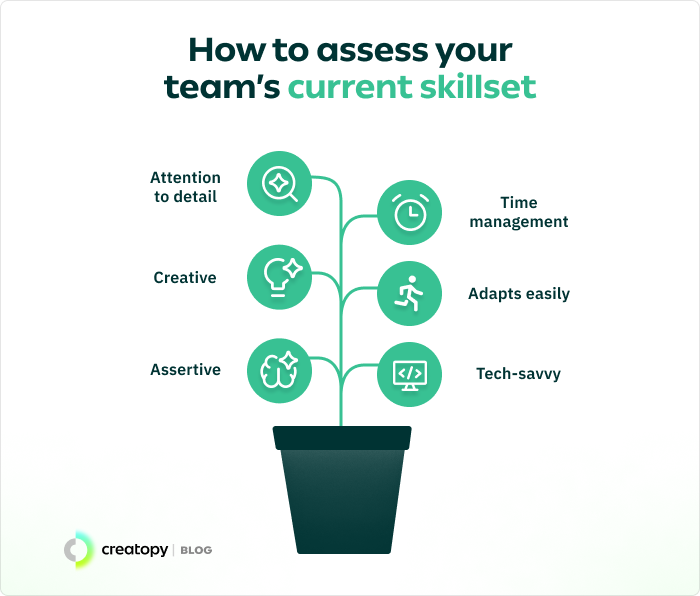
Before instilling new skills in your employees, you should first determine which relevant skills they already possess. You should employ your marketing team with individuals who are:
- Attentive to detail;
- Great with time management;
- Creative;
- Able to adapt to a fast-paced environment;
- Assertive;
- Tech-savvy.
Of course, there are numerous qualities aside from the ones above in marketing professionals should possess. You can determine which qualities they have already and which ones you may have to instill in them in a variety of ways. For instance, you can have employees perform the expected duties associated with their role in the company to ensure they’re up to par.
You may consider having a one-on-one discussion with each person, asking them what they believe their strengths are. Doing so is a great way to ensure staff are performing tasks that cater to their skillset, rather than overwhelming them with those they’re unable to complete to the highest quality.
Coordinating and collaborating
Implementing automation into your current marketing strategy is a great way to instill updated team building and collaborating efforts, as well. When you incorporate new tools, no matter what they are, it means you’ll have to find ways to effectively communicate how they work with your team, thus bringing everyone together.
Having strong internal communications between departments and other individuals on the marketing team is a must. Not only does it ensure everyone is on the same page, but it helps create a sense of comradery within the workplace, too. Be sure to play to each employee’s strengths when teaching them about new processes so that they fully understand them. Integrate this into your performance management cycle, where team members can track their progress and adapt to new automation requirements. Encourage your team to ask questions amongst each other when they find themselves stuck to help increase collaborative efforts in the workplace.
Develop the ultimate in-house marketing team
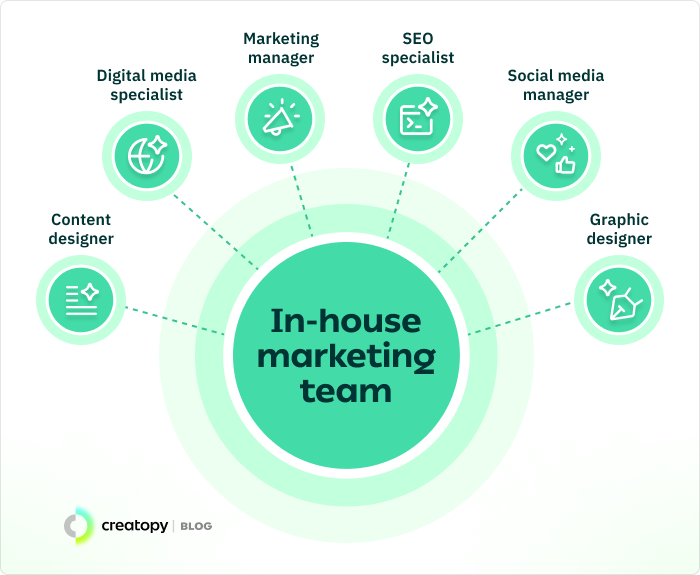
Those who notice a gap in skillset in either themselves or their employees may consider expanding their marketing department. Roles to consider filling include:
- Content designer: A content designer is responsible for developing compelling articles to post on the company website and use for digital advertisements.
- Digital media specialist: A digital media specialist is responsible for finding and utilizing the best online tools to help promote and develop digital campaigns.
- Marketing manager: The manager of marketing is responsible for overseeing daily operations in the marketing department.
- SEO specialist: A search engine optimization (SEO) specialist is someone who identifies, strategizes, and executes marketing tactics to improve the organic traffic of your website, thus helping you appear high on the Google search engine results pages (SERPs).
- Social media manager: A social media manager is responsible for overseeing everything that happens on the company’s social media account(s) including posting content and interacting with users.
- Graphic designer: A graphic designer’s role is to focus on developing eye-catching images and other multimedia for your digital and print advertising.
If hiring additional, more qualified individuals isn’t in your bandwidth, then you may consider investing in resources to help your current marketing team develop a strong skill set. Regardless of how you develop it, it’s important to have an in-house marketing team that’s capable of seeing out daily tasks.
Plan training sessions ahead of time
Whether you utilize online educational resources or in-person automation training sessions, scheduling a time ahead is ideal for employees who are encouraged to attend both. Not only is this helpful for the person hosting the training session, but it helps ensure employees can attend.
Additionally, it gives the host time to determine what to include in each training session like software to implement and real-time success stories of automation in marketing.
Stay in tune with digital marketing news and strategy trends
Finally, it’s beneficial for all to stay on top of industry trends. Research online hubs that highlight the latest and greatest in marketing, including what software to consider for a marketing strategy plan. A few resources to consider include, but aren’t limited to:
- Social media trends for digital marketing professionals;
- Educational webinars and seminars where marketing professionals alike can gather and discuss their questions, comments, and concerns after the fact;
- Tech-focused magazines and newspapers;
- Enrolling in continuing education courses to freshen up your IT and marketing skills;
- Signing up for free online courses that teach professionals how to embrace automation in the workplace.
Talk to other marketing professionals to see if they have any additional resources they recommend to help you and your team embrace automation in the department. Who knows, you may be one podcast away from learning all there is to know about automation in marketing.
Whether it’s to improve the content ideation process, store unlimited amounts of data, or generate banner ads for your website, applying automation to your current marketing strategy is a choice you and your team won’t regret. Ensure to use the software with the best reviews to ensure the changes you’re making to your strategy are, indeed, beneficial.



